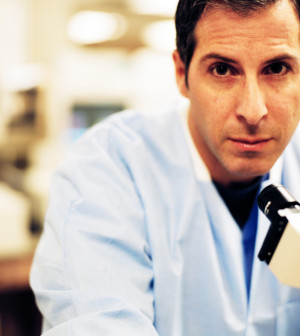- Navigating Your Midlife Crisis: Embracing New Possibilities
- City Raccoons Showing Signs of Domestication
- Mapping the Exposome: Science Broadens Focus to Environmental Disease Triggers
- One Week Less on Social Media Linked to Better Mental Health
- Your Brain Changes in Stages as You Age, Study Finds
- Some Suicide Victims Show No Typical Warning Signs, Study Finds
- ByHeart Formula Faces Lawsuits After Babies Sickened With Botulism
- Switch to Vegan Diet Could Cut Your Greenhouse Gas Emissions in Half
- Regular Bedtime Does Wonders for Blood Pressure
- Dining Alone Could Mean Worse Nutrition for Seniors
Angelina Jolie’s Mastectomies Tied to Rise in Genetic Testing

After actress Angelina Jolie had both breasts removed because she faced a heightened risk for breast cancer, there was a spike in the number of women who were tested for the genes that raise that risk. But, there was no corresponding increase in mastectomy rates, researchers report.
Jolie’s 2013 announcement about her decision was delivered in an editorial in The New York Times.
“That editorial was widely shared on social media, and we saw a jump in BRCA gene testing the day after the editorial,” said lead researcher Sunita Desai. She is a fellow in the department of health care policy at Harvard Medical School in Boston.
“In the two weeks after the editorial, we found a 64 percent jump in gene testing, compared with gene testing in the two weeks before the editorial, and a $13.5 million increase in spending on BRCA testing in this population,” she said. “The increased rates continued throughout the year.”
Although this study didn’t prove that Jolie’s decision caused more women to get tested, her editorial likely had that effect, Desai said.
“Thoughtful and well-delivered celebrity endorsements can be effective in raising awareness and use of preventive care,” she explained.
To measure the effect of the editorial, Desai and her colleague Dr. Anupam Jena, an associate professor of health care policy at Harvard, collected data on more than 9 million U.S. women aged 18 to 64. The researchers then analyzed rates of BRCA testing and mastectomies before and after Jolie’s editorial appeared in May 2013.
Testing rates rose from 0.71 per 100,000 women in the 15 business days before the editorial ran, to 1.13 per 100,000 women in the 15 business days after the editorial ran. This was an absolute daily increase of 0.45 tests per 100,000 women, Desai said.
The year before, BRCA test rates remained basically unchanged during the same time period, the study authors noted.
However, the jump in BRCA test rates was not accompanied by an increase in mastectomy rates, Desai noted.
Instead, monthly mastectomy rates among women who had BRCA testing dropped from an average of 10 percent during January-April 2013 to 7 percent during May-December 2013. This suggests that the increased BRCA testing that followed the editorial did not find gene mutations requiring preventive mastectomy, Desai said.
So, while celebrities can help raise awareness about specific health issues, they might not effectively target those most at risk, she suggested.
“BRCA testing is most effective among women with a family history of breast cancer or other risk factors, so it does not make sense for every woman to get tested, and it can lead to over-utilization,” Desai noted.
“It’s important for patients to do their own research and to talk to their doctor to figure out what’s best for them,” she added.
One expert agreed that just because a celebrity advocates something doesn’t make it right for everyone. Moreover, consumers need to seek out the best information they can, particularly about things that affect their health.
“We live in an era when truth is much more in the hands of the consumer,” said Dr. Len Lichtenfeld, deputy chief medical officer for the American Cancer Society.
“Celebrities have a responsibility to be truthful about what they know and what they don’t know, and not make grand recommendations based on their own individual experience, because that’s not the way to communicate about population health,” he said.
People need to get the best advice they can find from those most qualified to give it, Lichtenfeld said.
“Consumers have to be aware that not everything they hear or read is true,” he said.
More information
Visit the American Cancer Society for more on breast cancer.
Source: HealthDay
Copyright © 2025 HealthDay. All rights reserved.










